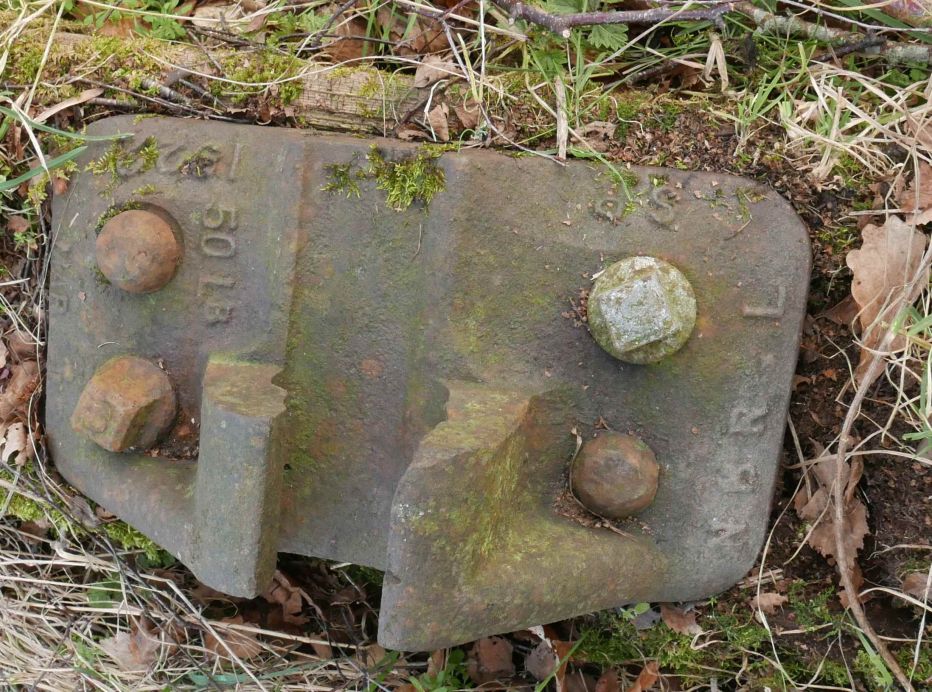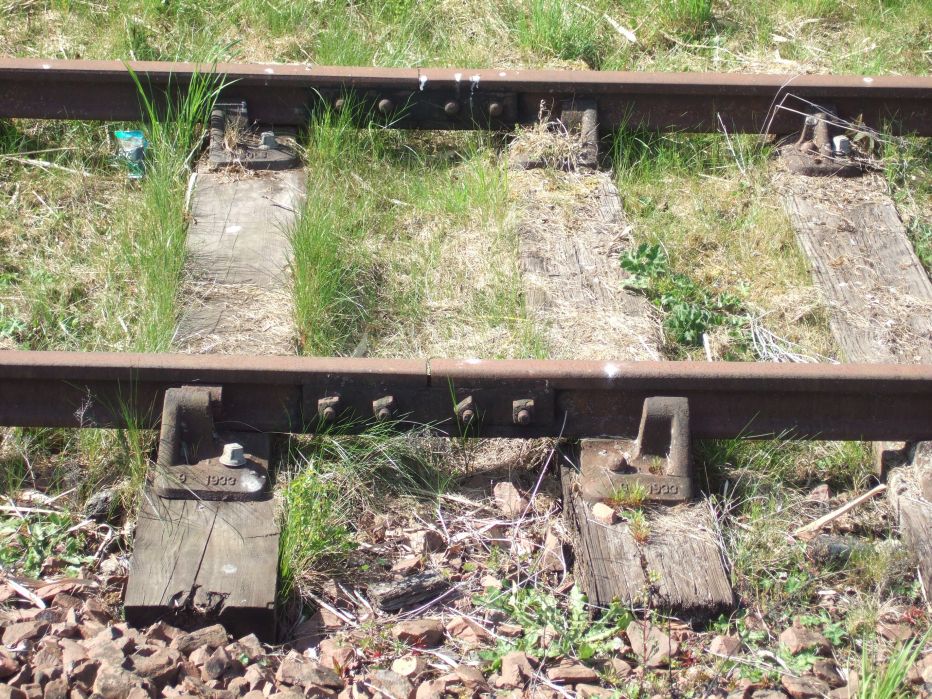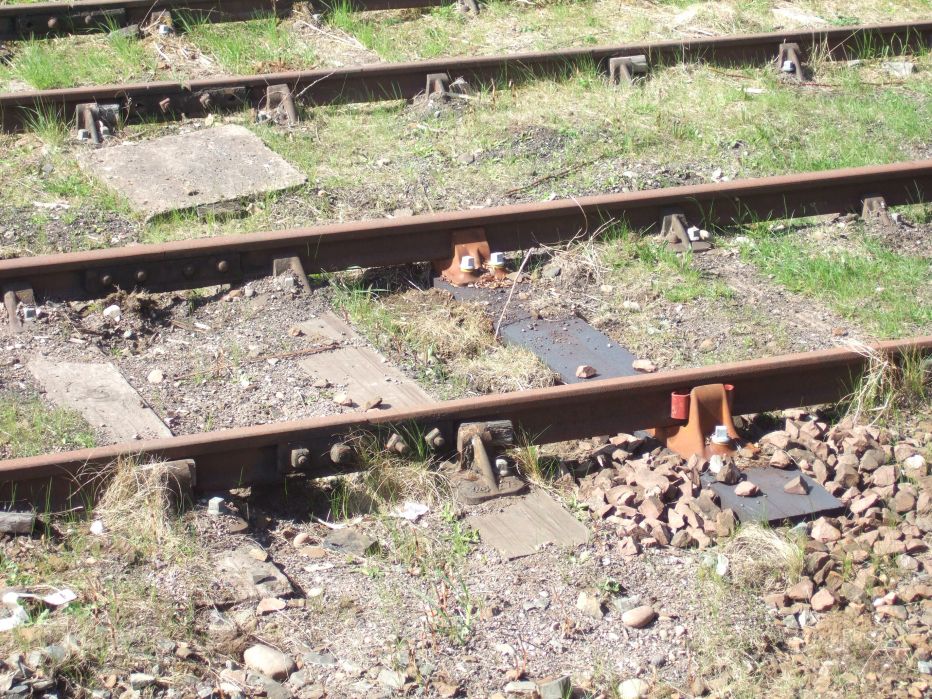Templot Club Archive 2007-2020
|
|||
| author | remove search highlighting | ||
|---|---|---|---|
|
posted: 2 Apr 2017 23:30 from: grahamroberts click the date to link to this post click member name to view archived images |
Out walking today, I came across the remains of a quarry siding off the erstwhile Waverley Route (the modern Border Railway), and was interested to find a few unconventionally-shaped NBR bullhead rail chairs dated 1922, still in place on their sleepers. There were several sleepers' worth of these, in left-hand and right-hand patterns: 62_021819_420000000.jpg  62_021820_190000000.jpg  Are these chairs possibly for rail-built buffer-stops? (they were close to the end of the siding). If not, what is the wider base-plate for? regards Graham Roberts |
||
|
posted: 3 Apr 2017 00:14 from: Martin Wynne
click the date to link to this post click member name to view archived images |
Hi Graham, My guess (purely a guess) is that they are joint chairs. Allowing the rail to be supported as close to the joint as possible while leaving space for the fishplate. If so, and found near the end of a siding they were probably on a second-hand track panel, where connected to the buffer stop. If there were several sleepers worth in a row, that theory is out (unless an odd length of track was made up using a job lot of old chairs). Interesting that they have the late date of 1922 on them for a pre-grouping design. Thanks for posting the pictures. regards, Martin. |
||
|
posted: 3 Apr 2017 09:26 from: Bruce M
click the date to link to this post click member name to view archived images |
Hi Graham, The chairs are indeed rail joint chairs. There were several joints like this on the down sidings at Leuchars well into the 1990's and they may still be there under the foliage. Would you mind if I put your photo on the NB Study Group forum? Bruce M |
||
|
posted: 3 Apr 2017 19:30 from: grahamroberts click the date to link to this post click member name to view archived images |
Thanks Martin and Bruce. Martin, there were possibly only two adjacent sleepers with these chairs, so that fits with your theory. The other sleepers have a mix of NB and LNE chairs and have all been given 2 new squareheaded screw fixings so secondhand panels sounds correct. Bruce, interesting regarding Leuchars. More than happy for you to post on the NBRSG forum; I'm a member too but the forum doesn't seem to get much traffic. Maybe I could turn it into a short piece for the Journal. Regards Graham |
||
|
posted: 20 Apr 2017 21:47 from: Bruce M
click the date to link to this post click member name to view archived images |
Further to the above posts, I was able to take a trip to Leuchars today and was delighted to discover that the old sidings are refreshingly clear of greenery, allowing me to get a couple of photos. As can be seen, the chairs are used at the rail joints. The first item of interest is that the chairs, which are of the same pattern as the 1922 ones spotted by Graham, appear to be marked 1933! So, cast 10 years after the demise of the NB. The rails are 45' long and the plain chairs are NBR 4 hole units, so I would imagine that this is late NB mainline rail in reused chairs. The second thing that is of interest is that on a fair length of the siding, about 1 in 4 sleepers and chairs have recently been replaced with modern substitutes! This is presumably a minimal replacement to keep the track up to supporting ECS during major golf events at St. Andrews. So NBR rail and chairs still in use nearly a century after the end of the NBR! I'm trying to work out the logic of the asymmetric chair. Had the jaws been at the inboard end of the joint, I might have thought that it would have allowed even spacing of sleepers through the joint, facilitating mechanical tamping, but I would be staggered if the NB had that in mind. The thoughts of others would be illuminating. Now, who's going to build the model!3072_201638_000000000.jpg  3072_201640_060000000.jpg 3072_201640_060000000.jpg |
||
|
posted: 20 Apr 2017 22:20 from: grahamroberts click the date to link to this post click member name to view archived images |
Bruce, that's fascinating, and these are great photos. Thanks for posting them! Graham | ||
|
posted: 21 Apr 2017 10:49 from: John Palmer click the date to link to this post click member name to view archived images |
Thank you for posting these interesting pictures. How good it would be if someone would produce mouldings of the distinctive North British chairs! To me, the obvious intention of the design of these joint chairs is to make it possible to reduce the pitch between the sleepers on either side of the joint from 24”-26” to 18” - the length of a fishplate. Yet this hasn't been done here. Employment of these chairs doesn't appear to have been common. I have come across another possible example at Crail - see this link- where, again, there is a pitch of at least 24” between the sleepers on either side of the joint. See also Yeadon's Register of LNER Locomotives Vol. 26 for a couple of further examples. The foreground joint in the picture of J33 No. 9112 on p.22 is fitted with these chairs (location unspecified), as is the joint in the foreground of the picture of J36 No. 65346 at p.142. The latter picture does illustrate well how the sleeper pitch can be closed up if these joint chairs are used, but surprisingly the location is at Inverurie in GNoSR territory. A case of making use of what the relevant Scottish Region PW department had to hand? |
||
|
posted: 21 Apr 2017 11:02 from: Martin Wynne
click the date to link to this post click member name to view archived images |
John Palmer wrote:To me, the obvious intention of the design of these joint chairs is to make it possible to reduce the pitch between the sleepers on either side of the joint from 24”-26” to 18” - the length of a fishplate.Or even with sleepers side by side, with 2-bolt fishplates? There was much experimenting with the design of rail joints in the early days. It was a long time before the convention of putting all the strength in the fishplate was generally adopted, rather than having special heavier timbers or special joint chairs. Many thanks Bruce for some great pics. Martin. |
||
| Please read this important note about copyright: Unless stated otherwise, all the files submitted to this web site are copyright and the property of the respective contributor. You are welcome to use them for your own personal non-commercial purposes, and in your messages on this web site. If you want to publish any of this material elsewhere or use it commercially, you must first obtain the owner's permission to do so. |